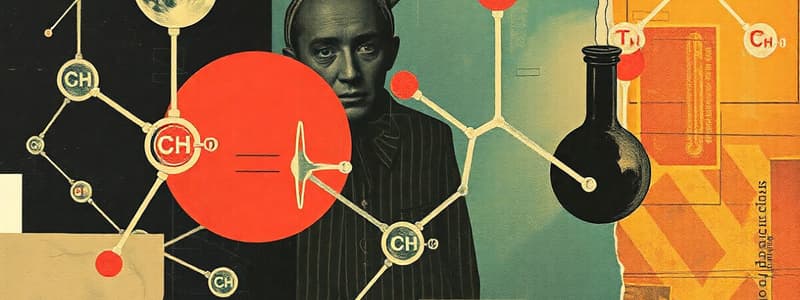Podcast
Questions and Answers
What causes a metal atom to become a positively charged cation?
What causes a metal atom to become a positively charged cation?
- Forming an ionic bond
- Gaining electrons
- Attracting electrons
- Losing electrons (correct)
Which statement is true about the ionic bond?
Which statement is true about the ionic bond?
- It involves only the transfer of protons.
- It forms only between metals.
- It occurs when two nonmetals share electrons.
- It is the result of the electrostatic attraction between oppositely charged ions. (correct)
What happens to the ions in an ionic compound when it is melted or dissolved in water?
What happens to the ions in an ionic compound when it is melted or dissolved in water?
- They become fixed in place.
- They form covalent bonds.
- They are free to move. (correct)
- They lose their charges.
How does the size of ions affect the strength of ionic bonds?
How does the size of ions affect the strength of ionic bonds?
Which property of ionic compounds explains their brittleness?
Which property of ionic compounds explains their brittleness?
What is the reason ionic compounds are non-conductive in the solid state?
What is the reason ionic compounds are non-conductive in the solid state?
What determines the solubility of ionic compounds in polar solvents?
What determines the solubility of ionic compounds in polar solvents?
What characterizes the crystal lattice structure of ionic compounds?
What characterizes the crystal lattice structure of ionic compounds?
Flashcards
Ionic Bonding
Ionic Bonding
The electrostatic attraction between oppositely charged ions, forming a crystal lattice.
Cation
Cation
A positively charged ion formed when a metal loses electrons.
Anion
Anion
A negatively charged ion formed when a nonmetal gains electrons.
Crystal Lattice
Crystal Lattice
Signup and view all the flashcards
High Melting Point (Ionic Compounds)
High Melting Point (Ionic Compounds)
Signup and view all the flashcards
Ionic Compound Conductivity (Melted/Dissolved)
Ionic Compound Conductivity (Melted/Dissolved)
Signup and view all the flashcards
Ionic Compound Brittleness
Ionic Compound Brittleness
Signup and view all the flashcards
Solubility Factors (Ionic Compounds)
Solubility Factors (Ionic Compounds)
Signup and view all the flashcards
Study Notes
Ionic Bonding
- Ionic bonding is the electrostatic attraction between oppositely charged ions.
- It occurs when a metal atom loses one or more electrons to become a positively charged cation, and a nonmetal atom gains those electrons to become a negatively charged anion.
- The electrostatic attraction between the oppositely charged ions forms a crystal lattice structure.
- This structure is characterized by high melting and boiling points.
- Ionic compounds are typically formed between metals (low ionization energy) and nonmetals (high electronegativity).
- The transfer of electrons results in the formation of ions with complete outer electron shells, attaining a stable electron configuration.
Formation of Ionic Bonds
- Electron transfer from a metal to a nonmetal creates ions.
- The metal loses electrons, becoming a positive ion (cation).
- The nonmetal gains electrons, becoming a negative ion (anion).
- The opposite charges attract each other strongly creating an ionic bond.
- The attraction holds the ions together in a 3D crystal lattice structure.
- The strength of the ionic bond depends on the charges on the ions and their size (smaller ions lead to stronger bonds).
- The process involves energy changes (ionization energy and electron affinity)
Properties of Ionic Compounds
- High melting and boiling points: Strong electrostatic forces between ions require a significant amount of energy to overcome.
- Brittle: Applying pressure can cause ions with the same charge to line up, leading to repulsion and the crystal structure breaking.
- Conductivity: When melted or dissolved in water, ionic compounds conduct electricity because the ions are free to move.
- Solubility: Many ionic compounds are soluble in polar solvents like water due to the attraction between the ions and the polar molecules of the solvent.
- Crystalline structure: The ions arrange themselves in a regular, repeating pattern in a crystal lattice.
- Hard: The strong electrostatic forces between ions result in hard, rigid solids.
- Non-conductivity in solid state: In a solid state, the ions are fixed in place within the crystal lattice, and therefore cannot conduct electricity.
- Solubility depends on the relative strength of attractions between ions and solvent molecules. Solvents with high polarity tend to dissolve ionic compounds effectively.
- Formation of strong electrolytes: Ionic compounds dissolve in water to form ions that dissociate completely.
Studying That Suits You
Use AI to generate personalized quizzes and flashcards to suit your learning preferences.




